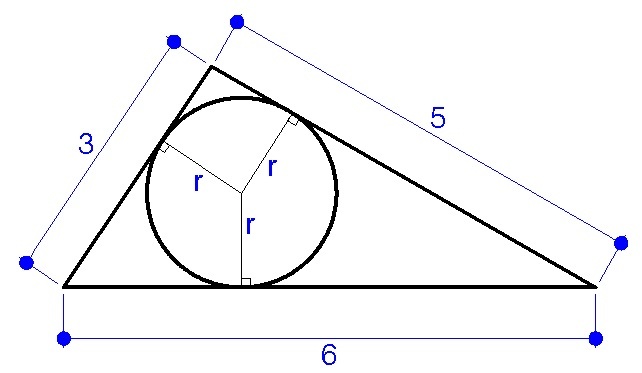The largest circle
What is the area of the largest circle that can be inscribed in a triangle with side lengths of 3, 5 and 6?
If you think the answer is b a π , where a and b are coprime positive integers, insert your answer as a + b .
The answer is 15.
This section requires Javascript.
You are seeing this because something didn't load right. We suggest you, (a) try
refreshing the page, (b) enabling javascript if it is disabled on your browser and,
finally, (c)
loading the
non-javascript version of this page
. We're sorry about the hassle.
2 solutions
Relevant wiki: Incircle of Triangle

The radius of the incircle is given by the formula r = P 2 A where: A = area of the triangle and P = perimeter of the triangle
The area of the triangle can be computed using the Heron's Formula , A = s ( s − a ) ( s − b ) ( s − c ) where: s = semi-perimeter of the triangle, a , b , c = side lengths of the triangle
s = 2 3 + 5 + 6 = 7
A = 7 ( 7 − 3 ) ( 7 − 5 ) ( 7 − 6 ) = 5 6 = 2 1 4
P = 3 + 5 + 6 = 1 4
Computing for the radius of the incircle, we have
r = 1 4 2 ( 2 1 4 ) = 7 2 1 4
Computing for the area of the incircle, we have
A = π r 2 = π ( 7 2 1 4 ) 2 = π [ 4 9 4 ( 1 4 ) ] = π ( 4 9 5 6 ) = 7 8 π
Finally,
a + b = 8 + 7 = 1 5 answer
The largest circle inscribed in the triangle is its incircle with its centre having equal perpendicular distances, its radius r , to the three sides (see figure above).
Therefore, the area of the triangle is given by A = 2 1 ( a + b + c ) r , where a , b and c are the sides lengths of the triangle. And by Heron's formula we have A = s ( s − a ) ( s − b ) ( s − c ) , where s = 2 a + b + c . Therefore, we have:
2 ( a + b + c ) r s r ⟹ r = s ( s − a ) ( s − b ) ( s − c ) = s ( s − a ) ( s − b ) ( s − c ) = s ( s − a ) ( s − b ) ( s − c ) = 7 ( 7 − 3 ) ( 7 − 5 ) ( 7 − 6 ) = 7 8 Note that a = 3 , b = 5 , c = 6 , ⟹ s = 7
Therefore, the area of the incircle A ∘ = π r 2 = 7 8 π . ⟹ a + b = 8 + 7 = 1 5